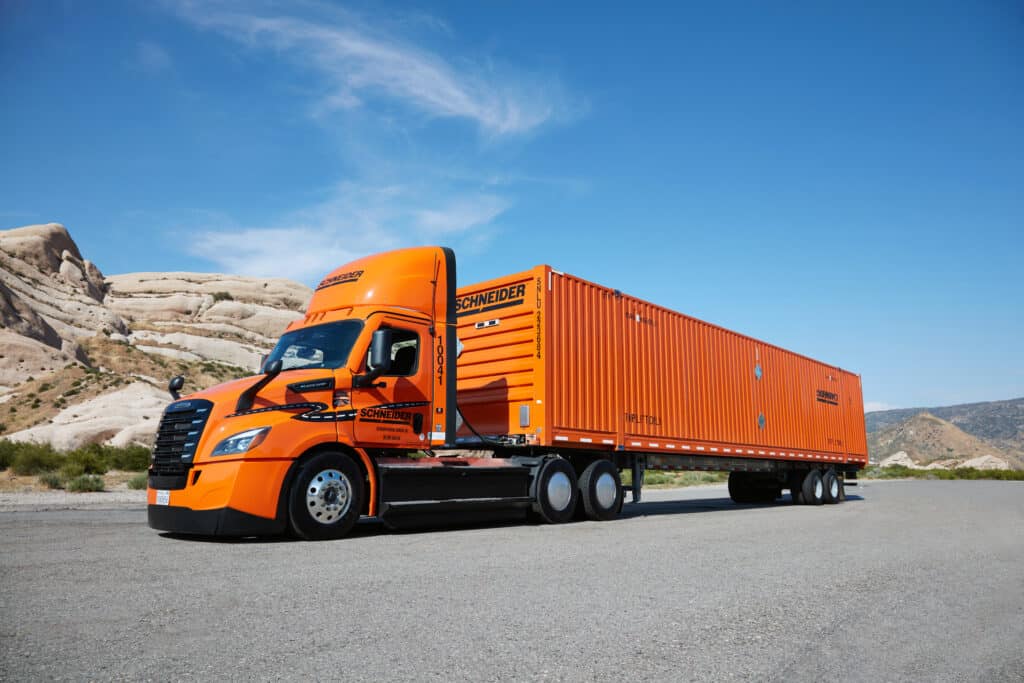Schneider Opens Large-Scale Zero Emission Electric Charging Depot at South El Monte Intermodal Operations Center in Southern California
In a significant leap towards sustainability, Schneider, a global specialist in energy management and automation, has announced the opening of a large-scale, zero-emission electric charging depot at its South El Monte Intermodal Operations Center in Southern California. The depot is a part of Schneider’s ongoing commitment to reducing carbon emissions, enhancing renewable energy use, and pioneering green technology. This initiative marks a turning point in the industry, setting a precedent for other companies to follow. It’s an important stride towards a greener, cleaner, and more sustainable future.

The depot is specifically designed to power Schneider’s battery electric truck (BET) fleet. By the end of the year, this fleet will encompass nearly 100 Freightliner eCascadias, making it one of the largest zero-emission fleets in North America. The utilization of top-tier electric trucks underscores Schneider’s dedication to implementing advanced technologies to further their sustainability goals. This fleet transformation is not just a significant achievement for Schneider, but also a milestone for the logistics and transportation industry.
The charging site sprawls over an area larger than half a football field
The charging site sprawls over an area larger than half a football field and boasts 16 dual-corded dispensers, each offering a hefty 350 kW of power. This capacity enables Schneider to charge up to 32 trucks at the same time. The Freightliner eCascadias, with their advanced charging capabilities, can reach 80% battery capacity within just 90 minutes. This rapid charging feature ensures minimal downtime for the fleet and maximizes operational efficiency, further demonstrating Schneider’s commitment to environmental sustainability without compromising on performance.
“Schneider decided to lead the way by building our own depot in South El Monte,” said Schneider President and CEO Mark Rourke. “It was important to develop onsite charging because it is the most efficient solution to power our growing electric fleet. With the infrastructure deficiency, we found that we needed to collaborate with a wide array of experts to see our vision come to fruition.” This statement underscores the commitment and strategic thinking that Schneider has applied in their quest for a more sustainable future. The collaborative approach also highlights the need for various stakeholders to come together and work towards a common goal of sustainability. The initiative undertaken by Schneider serves as an inspiration and a benchmark for other companies in the logistics and transportation industry.
Schneider has commenced deliveries for Frito-Lay North America and Goodyear
Already in this year, Schneider has commenced deliveries for two major players, Frito-Lay North America and Goodyear, leveraging its new eCascadia fleet. This venture not only marks an operational expansion for Schneider but also signifies its active role in supporting the sustainability goals of these companies’ supply chains. The eCascadias, boasting an impressive range of approximately 220 miles, provide a viable and efficient solution for short to medium-haul deliveries. They stand as a testament to Schneider’s strategic shift towards environmentally-friendly logistics, while delivering top-notch service to its clients.
The site was made possible through funding from the Joint Electric Truck Scaling Initiative (JETSI)
The construction of the South El Monte site was made possible through funding from the Joint Electric Truck Scaling Initiative (JETSI). This project, backed by state and local agencies, is designed to increase the prevalence of zero-emission heavy-duty trucks on the roads. To ensure a successful and efficient construction, Schneider joined hands with other companies that share a commitment towards sustainable solutions. One such company is Black & Veatch, a global leader in clean transportation engineering and construction. Collaborating with Black & Veatch enabled Schneider to design and build a site that optimized operational efficiency while maintaining a minimal environmental impact. This partnership not only signifies Schneider’s dedication towards environmental sustainability, but also represents a significant stride towards cleaner and more sustainable logistics operations nationwide.
“This 4,900-square-foot state-of-the-art electric truck charging hub is a monumental testament to innovation and collaboration,” said Dave Hallowell, Black & Veatch president of the connectivity, commercial, and industrial sector. “The collaboration between Schneider and all the project partners will result in new employment opportunities for the area, along with a significant reduction in pollution.”
The funding for a substantial portion of Schneider’s 92 Battery Electric Trucks (BETs) was facilitated by JETSI, the inaugural battery electric truck initiative jointly backed by the California Air Resources Board and the California Energy Commission. These organizations jointly contributed a whopping $27 million to the project. Moreover, the South Coast Air Quality Management District, Mobile Source Air Pollution Reduction Review Committee, the Port of Los Angeles, and Southern California Edison provided additional funding. The JETSI project is a part of the broader California Climate Investments – a statewide initiative that utilizes billions of cap-and-trade dollars to actively reduce greenhouse gas emissions. This initiative simultaneously strengthens the economy and enhances public health and the environment, especially focusing on disadvantaged communities.
“We know the future of sustainable transportation includes electric. That is why we invested and collaborated with stakeholders along the supply chain to work together to create this infrastructure and ultimately lower carbon emissions. This would not be possible without our funding and grant agencies,” said Rourke.
Beyond the funding allocated through JETSI, the remaining 42 trucks have diverse funding sources. Five are jointly funded by the U.S. Environmental Protection Agency’s FY18 Targeted Airshed Grant and the Hybrid and Zero-Emission Truck and Bus Voucher Incentive Program (HVIP). Seven get their funding from the Volkswagen Environmental Mitigation Trust, while the remaining 30 trucks are solely funded by HVIP. Schneider’s partnership with Daimler Truck North America (DTNA) played a crucial role in the evolution of eCascadia. Schneider piloted a truck for six months from 2019 to 2020 through Freightliner’s Customer Experience fleet. Feedbacks received from Schneider drivers and the equipment team significantly contributed to the production of the current Battery Electric Trucks (BETs) in the company’s fleet.
“For decades, we’ve built a strong, deep relationship with Schneider, aligning on strategic priorities such as safety and efficiency,” said Daimler Truck North America Senior Vice President, Sales and Marketing David Carson. “When initiating our electric vehicle development programs, we assisted Schneider as they started and later scaled their fleet of Freightliner eCascadias. They’ve provided our team with vital insight on the opportunities for battery electric trucks in the goods movement industry. Through the outreach and education being conducted as part of the JETSI project, other fleets can learn from Schneider’s experiences and apply them to future deployment of zero emission vehicles nationwide.”
Schneider has taken delivery of nearly one-third of its expected fleet
At present, Schneider has taken delivery of nearly one-third of its expected fleet. Once all these Battery Electric Trucks (BETs) are fully operational, they hold the potential to significantly reduce carbon emissions. In fact, it is estimated that they could help dodge more than 81,000 pounds of carbon dioxide emissions each day. This is equivalent to eliminating 2,400 gas-powered cars from the roads. Each day, these zero-emission trucks will contribute to Schneider’s efforts towards achieving its environmental goals. The company aims to reduce its CO2 emissions by 7.5% per mile by 2025 and ambitiously targets a 60% per mile reduction by 2035. The introduction of these BETs is a key step towards this vision, representing tangible progress in the company’s commitment to environmental sustainability.
For more information on Schneider’s fleet sustainability initiatives, please visit: https://schneider.com/company/corporate-responsibility.
To learn more about the JETSI project, please visit: https://www.jetsiproject.com.
